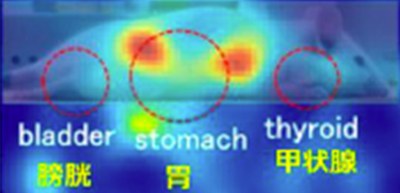
Hybrid Compton camera imaging that can visualize a variety of X-ray and gamma ray sources developed
Researchers from Osaka University, The University of Tokyo, and The Institute for Radiation Sciences developed a “hybrid” Compton camera that can simultaneously achieve X-ray and gamma-ray imaging ranging from a few tens of keV to MeV by combining features of “Compton” and “pinhole” cameras in a single detector system.
X-rays and gamma rays, electromagnetic radiation that has high penetrating power, will simply pass straight through objects and are not refractive enough to be collected with a normal lens or mirrors. Thus, researchers have made efforts to develop imaging methods based on the direction and energy of incident gamma-ray photons; however, it is difficult to realize simultaneous wide-band imaging ranging from a few tens of keV to MeV in a single camera because different interactions between photons and detector materials occur, depending on the photon energies.
As gamma-ray photons of energy greater than 100 keV pass through the crystal, they collide with electrons in it. This process is called Compton scattering, wherein a gamma ray strikes an electron and loses energy, creating charged particles that can be detected by the sensor.
In recent years, Compton cameras that can visualize higher-energy gamma rays have been developed. The Compton camera concept is based on the reconstruction of recorded Compton scattering events of incoming gamma rays. Commonly, the Compton camera consists of two layers of scintillator arrays: a scatterer detector and an absorber detector. Using the Compton scattering equation, it is possible to determine the scattering angle and estimate possible directions of the original gamma rays. When the Compton camera records the number of such events, the location and the shape of the gamma source can be reconstructed.
In Compton cameras, the forward layer acts as a scatterer for high-energy photons (> 200 keV) and an active pinhole for low-energy photons (< 200 keV). Most photons generated by the X-ray source are absorbed by a collimator, with only a small number of photons able to pass through the pinhole. Since low-energy gamma rays stop at the scatterer and do not reach the absorber, only high-energy photons (> 200 keV) can be visualized by conventional Compton cameras.
In this study, the researchers created an active 5×5mm2 pinhole in its center of the scatterer of the hybrid Compton camera so that low-energy X-rays and gamma rays could reach the absorber. Since only low-energy X-rays and gamma rays pass through the pinhole and undergo photoabsorption, they are imaged by the pinhole mode, while high-energy gamma rays are imaged by the Compton mode.
The researchers simultaneously imaged americium 241 (241Am) (60 keV) and caesium 137 (137Cs) (662 keV) in the same field of view, achieving an angular resolution of 10∘ (FWHM (full width at half maximum)) for both sources. The 241Am source was reconstructed in the pinhole mode (60 keV), whereas the 137Cs source was reconstructed in the Compton mode (662 keV).
They also imaged a mouse injected with 1MBq of astatine-211 (211At), a nuclear medicine, accumulated in the body via pinhole-mode measurement. With the hybrid Compton camera, the pinhole image depicted that the distribution of the 211At converged on the thyroid, stomach, and bladder from 11,755 events obtained after 1 h of measurement. 79 keV X-rays were found to be advantageous over 570 keV gamma rays for imaging 211At.
This hybrid Compton camera that allows for the simultaneous visualization of low-energy X-rays to high-energy gamma rays will explore ways of new applications for making diagnoses in medicine and for observing x-rays and gamma rays in space science.
Figure 1
Figure 2
Figure 3
Figure 4
Figure 5
Figure 6
The article, “Performance demonstration of a hybrid Comptoncamera with an active pinhole for wide-band X-ray and gamma-ray imaging,” was published in Scientific Reports at DOI: https://www.nature.com/articles/s41598-020-71019-5.
Related Links
